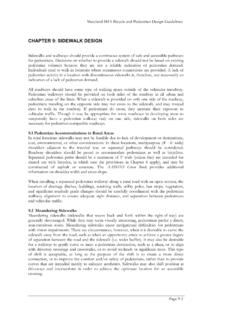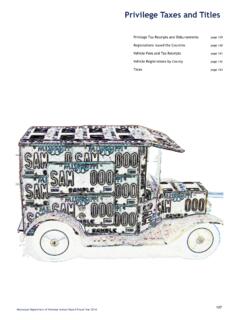Transcription of CONSTRUCTION GUIDELINES - Maryland State Highway ...
1 Maryland = S. WATERWAY. CONSTRUCTION . GUIDELINES . Maryland DEPARTMENT. OF THE ENVIRONMENT. WATER MANAGEMENT ADMINISTRATION. Maryland =S. GUIDELINES TO. WATERWAY. CONSTRUCTION . Maryland DEPARTMENT OF THE ENVIRONMENT. WATER MANAGEMENT ADMINISTRATION. ISSUED SEPTEMBER, 1999. REVISED NOVEMBER, 2000. The facilities and services of the Department of the Environment are available to all without regard to race, color, religion, sex, age, national origin, physical or mental disability. ACKNOWLEDGEMENTS. We would like to acknowledge the many people and organizations that helped us develop this document. The September 1999 manual revision was prepared for the Maryland Department of the Environment under a contractual agreement with Pennsylvania State University pursuant to EPA grant number CD993256-01-1. This document could never have been prepared without the talents, experience and hard work of Dr. Peggy A. Johnson and Eric Brown, Department of Civil Engineering, Pennsylvania State University.
2 Special thanks are also extended to Jeff Follweiler (Project Manager), Ali Mir (Chief Engineer, Nontidal Wetlands and Waterways Division), and Dave Rosgen (Wildland Hydrology). We would also like to acknowledge Jean Kapusnick, for her outstanding efforts to prepare the November 200 revision of the document. Thanks are also extended to personnel from the following organizations who graciously gave their time and advice, and whose insightful comments in reviewing earlier drafts were most helpful in revising the document: Anne Arundel County Department of Public Works Baltimore City Department of Public Works Baltimore County Department of Environmental Protection and Resource Management Baltimore County Soil Conservation District Environmental Quality Resources, Inc. Grading Specialists, Inc. KCI Technologies, Inc. Harford County Department of Public Works Maryland Department of the Environment Wetlands and Waterways Program Maryland Department of the Environment Nonpoint Source Program Maryland Department of General Services Maryland State Highway Administration Office of Bridge Development Maryland State Highway Administration Highway Hydraulics Division Prince George's County Department of Public Works Washington County Engineering Department Wildland Hydrology _____.
3 M ARYLAND DEPARTMENT OF THE ENVIRONMENT. W ATERWAY CONSTRUCTION GUIDELINES . REVISED NOVEMBER 2000. F ORWARD. The Maryland Department of the Environment Water Management Administration is pleased to announce the issuance of the Maryland GUIDELINES to Waterway CONSTRUCTION (MGWC) to provide a set of recommended details for approaches frequently encountered in the waterway CONSTRUCTION process. The need for this manual has been recognized over the years with the awareness that many streams and rivers require stabilization, modification, or rehabilitation of some type due to urbanization or previous channel CONSTRUCTION . Additionally, the emphasis for in-stream projects has gradually shifted from the use of hard points, such as rock and concrete structures, to a Asofter@, more environmentally acceptable approach, commonly referred to as biotechnical engineering, thereby necessitating revision of the previous GUIDELINES . Maryland is composed of five distinct physiographic regions which have widely varying geology and topography.
4 These regional and site-specific characteristics coupled with the level of watershed urbanization lend to the dissimilar behavior of streams in this State . Although the purpose of this manual is to function as a design aid for the use of structures and bio-engineering techniques in stream enhancement and restoration projects, development of a set of comprehensive design GUIDELINES is impractical due to the highly diverse nature of these streams and their associated floodplains and watersheds. Therefore, it is suggested that project designers, engineers, inspectors, and regulatory officials view the details and CONSTRUCTION sequences as GUIDELINES rather than as strict requirements or design standards for the waterway CONSTRUCTION permitting process with the additional understanding that these GUIDELINES may require supplemental details depending on the scope of the work. It should also be understood that the project manager or regulatory official may supersede these GUIDELINES on the basis of practical experience and/or recent developments with relevant field work and case studies.
5 Additionally, reference reaches in watersheds with similar physiographic, geologic, and hydraulic characteristics may indicate necessary modifications to the information presented in this document and should be used as templates for channel stabilization and restoration projects whenever possible. M ARYLAND DEPARTMENT OF THE ENVIRONMENT. W ATERWAY CONSTRUCTION GUIDELINES REVISED. REVISED NOVEMBER 2000. INTRODUCTION. The intent of this manual is to address a wide range of common biotechnical engineering techniques and conventional, Ahard@ engineering solutions with the hope of identifying effective uses and limitations, material specifications, and installation procedures for these measures. A. summary of the uses of common stabilization and restoration practices included in this document is provided in Table 1. Additionally, a listing of the principal limitations of each practice is given in Table 2. Throughout the GUIDELINES , where applicable, the stream types for which the practices are appropriate are given in terms of the Rosgen classification scheme (see Table 3).
6 Although not addressed in these GUIDELINES , it is important to assess the causes of any instability problem prior to designing a channel restoration or stabilization project. For example, streambank stabilization involving the installation of a structure may also involve re-shaping the channel in order to provide for the stable distribution of energy. Additional information on causes of unstable channels can be found in the Department of Agriculture's Interagency Stream Corridor Restoration Handbook Page ( ). Design Flows The planning of many in-stream CONSTRUCTION , stabilization, and restoration measures depends on the magnitude and frequency of a design flow event. Many techniques used for bank stabilization, including toe protection and surface armoring, are required to accommodate bankfull flow velocities and shear stresses. Bankfull velocities for design purposes can be estimated from Manning=s equation as follows: 2/3 1/2. V= R S. n where = or for or metric units, respectively, n = Manning=s roughness coefficient approximated for bankfull conditions, R = the hydraulic radius associated with bankfull depth and width, and S = slope.
7 Once the bankfull velocity is determined, the corresponding stone diameter to resist this velocity can be found in MGWC The average boundary shear stress at a cross section can be estimated from: o= R S. where = specific weight of water. MDE may require more extensive modeling efforts if tractive force (shear stress) regulations are to be reviewed. Bankfull discharge (in a stable channel) is defined as the maximum discharge which can be contained within the channel without over-topping the banks (Thorne et al., 1998). The bankfull depth is the flow depth associated with the bankfull discharge. In a stable channel, the bankfull discharge is thought to be the discharge which forms and maintains the present morphology of the channel. In an unstable channel, the bankfull discharge used for design purposes should reflect the bankfull discharge that would be expected if the channel were stable. Reference reaches, effective discharge studies, or bankfull indicators can be used to determine this magnitude.
8 Maryland DEPARTMENT OF THE ENVIRONMENT. WATERWAY CONSTRUCTION GUIDELINES . REVISED NOVEMBER 2000. Temporary measures for dewatering and diverting flow from a reach for CONSTRUCTION purposes should have sufficient capacity to convey 2-year flows for existing development conditions. For projects where hydrologic data is not available, bankfull flows may be substituted for the 2-year storm event. Design flows for temporary structures could be reduced to a lower flow if the project will take less than 2 weeks. Cost Information Approximate costs are included in the GUIDELINES for rough planning and comparative purposes only and may vary significantly based on local conditions and constraints. The costs were derived from King, , Bohlen, and Kraus, (1994), Stream Restoration: The Costs of Engineered Bioengineered Alternatives. Costs for the November 2000 revision of the GUIDELINES were updated from the costs provided in the 1999 draft using Engineering News Record CONSTRUCTION Cost Indexes.
9 Annual average values of 4985, 5408, and 6060 were used for the years 1992, 1994, and 1999 respectively. Comprehensive Stream Enhancement Plan The planning and design of any stabilization, restoration, or in-stream CONSTRUCTION project should include a set of clearly defined restoration objectives, a comprehensive monitoring strategy, and an adaptive management plan. Objectives vary from aesthetic improvements to habitat enhancement to safety and installation of hydraulic structures and roadways. Identifying the objective of the project must be accomplished before the design process can begin. Regardless of the nature of the objective, it should include measurable performance criteria. Performance criteria are quantitative measurements that are made in the stream corridor and compared to the project's objectives. Performance criteria can include parameters such as suspended sediment load and rate of lateral channel migration. A comprehensive monitoring strategy including appropriate baseline studies and timing, frequency, and location of field measurements, is requisite to assess the degree of project success or failure and to determine an adaptive management plan.
10 Options for an adaptive management plan include adjustment or maintenance of individual measures, modification of project goals and objectives, and project redesign. References Thorne, , Soar, , Hey, , and Watson, (1998). Dominant Discharge Calculation: A Practical Guide. US Army Research, Development, and Standardization Group - UK, London. Rosgen, D. L. (1996). Applied River Morphology. Wildland Hydrology, Pagosa Springs, CO. Maryland DEPARTMENT OF THE ENVIRONMENT. WATERWAY CONSTRUCTION G UIDELINES. REVISED NOVEMBER 2000. TABLE 1. S UMMARY OF THE USES OF COMMON RESTORATION AND. STABILIZATION PRACTICES. FUNCTIONAL APPLICATIONS. RESTORATION /. STABILIZATION armor & enhance propagate provide provide PRACTICE protect mass vegetative filter instream riparian surface stability growth sediment habitat habitat Brush Layering l l l l m w Brush Mattresses l m w l m w Fascines w m w l m w Live Crib Walls w l l m w m Live Stakes w w l w m w Natural Fiber Rolls w m l w m w Deflectors m m m m w m Gabions l w m m m m Root Wads w w w w l w Riprap, dumped l m m w m m Riprap, imbricated l l m w m m Boulder Placement m m m m w m Log Weirs m m m w w m Stone Dikes m m m l m m Rock Vanes l w m m w m Log Vanes l w m m w m J-Hooks l w m m l m Vortex Rock Weirs w m m m w m W Rock Weirs l w m m w m Key: l - the approach is well suited for this functional application (primary benefit).










